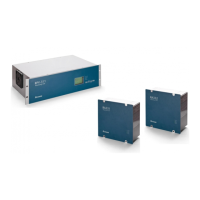Select the name of the stored configuration to be deleted and click on the REPORT button;
An HTML Web page will open with a list of all configuration parameters.
The report consists of a header with the following information: owner, identifier, and location of the
equipment, revision number, date and time of the last configuration change.
To print this report, click on the PRINT button.
2.3.10 TRANSMITTING A CONFIGURATION
To be able to transmit an equipment configuration, the user must be connected to the equipment by an
Ethernet or Modem interface.
Select the name of the stored configuration to be sent and click on the TRANSMIT button;
Type the IP address of the equipment that will receive the configuration;
Type the description of the configuration changes and click on the OK button;
Type the user name and the password to configure the equipment;
Click on the OK button to transmit the configuration and to go back to the main screen of the
Configuration Tool.
2.3.11 EXPORTING A CONFIGURATION
It is possible to export a configuration to the computer. To export a configuration, do the following:
Select the name of the stored configuration to be exported and click on the EXPORT button;
Type the name of the configuration file (.txt extension) and choose the storage location, then click on the
SAVE button.
The configuration file will be saved in the chosen location and can be imported into the RPV Tools.
2.4 TW FAULT LOCATOR
2.4.1 DESCRIPTION
The TW Fault Locator is a tool that uses the records of the traveling wave front signals at two ends of a
transmission line to locate a fault in this line.
To record traveling waves in RPV it is necessary to install the appropriate acquisition module, RA333. The
records of traveling waves at both ends of the line should be transferred of RPV's to the specific area of
records in the user's computer that will run the Fault Locator software.
By using a graphic interface, based on the distance between terminals A and B and on the time stamp of the
wave front, and by running the algorithm, the fault can be located. If unable to locate the fault automatically
by the software, it is necessary to use a graphical tool to identify the times of the wave front of each terminal
manually. Of the time identified it is possible run the fault locator graphically. If the locations of the towers
between the ends of the line are defined, the results are georeferenced and a KML file is created for viewing
through Google Earth.

